Navigating tomorrow partnering to shape enterprises of the future

The business landscape is evolving rapidly, marked by constant change and disruption. The future is not a static destination. It is a fluid milieu necessitating organizations to be agile and forward-thinking. Businesses must adopt a mindset of perpetual adaptation. They must keep reinventing to be relevant to the world that will be.
CZERO’s AI can help businesses accelerate sustainability journeys

CZERO’s AI can help businesses accelerate sustainability journeys CZERO’s AI can help businesses accelerate sustainability journeys A 2021 survey by BCG of 1,290 organizations worldwide finds, 85% of organizations were concerned about reducing their greenhouse gas emissions. To reduce the negative impact of their operations on the environment, 96% of them had set some targets for reducing emissions. However, only 11% of them have been able to reduce their emissions in line with their goals over the past five years. Under the enhanced transparency framework (ETF), established within the Paris agreement, an international treaty on climate change, starting 2024, countries will report transparently on actions taken and progress in climate change mitigation, adaptation measures and support provided or received. As a result, businesses must comply with expectations to track their carbon footprint more comprehensively and take concrete steps to mitigate it. Measurement is the key A company’s carbon footprint is the amount of GHG emissions that are released into the environment as a result of its operations. Carbon footprints for businesses are typically divided into three Scopes: Scope 1 covers direct emissions from business. Scope 2 entails indirect emissions such as electricity. These are emissions produced off-site from energy used on-site. Scope 3 emissions include those from other parts of the value chain. The Greenhouse Gas Protocol establishes comprehensive global standardized frameworks to measure and manage emissions across a company’s operations and value chains. The need of the hour is a tool that can provide an accurate picture of the actual processes, activities, and resources that directly contribute to the organization’s carbon emissions. Knowing the positive or negative impact can help manage emissions intelligently through quantitative measurement parameters. After all, you can manage only what you can measure! A guided maturity journey from monitoring to management with CZERO Measuring your carbon footprint is critical to identify carbon reduction opportunities and create a robust sustainability strategy. CZERO, an AI-powered application developed by Areteans, not only helps measure your company’s carbon emissions, but also provides a guided maturity journey from monitoring to management. CZERO –Measure, manage, monitor carbon emissions across the journeys of your business It identifies end-to-end emissions produced from various journeys of the business and steers you through the capture process to monitor emissions at every stage, recommend & automate improvement initiatives, and ultimately reduce emissions. Powered by Pega’s BPM Workflow, dynamic case management and Next-Best Action capabilities, the real value of CZERO lies in its power to capture emissions data from actual processes. Gathering data from specific emission points, it creates a guided path to reduce emissions. Jatin Patel, Senior Vice President and Regional Head of Europe at Areteans, believes that one of the critical first steps towards carbon neutrality is accurately measuring climate impact and monitoring it regularly. “With technologies like AI and tools like CZERO, organizations can adopt a scientific approach to turn their climate ambitions into concrete action,” he says. Track, Analyze and Reduce Your Carbon Footprint C-ZERO has innovative features across three phases that can help you achieve your carbon neutrality goals – Set Goals The application provides the following for you to set your carbon neutral goals – Guided forms to set goals An extensive repository of contributing entities to select from Industry and sector specific drivers and coefficients Extendable data capture forms Guided and configurable flows for easy adoption Monitor and Plan You can get accurate data, efficient calculations and end-to-end visibility of the process with Connectors to enable central repository for carbon tracking Benchmarking carbon emission calculations based on market insights Prebuilt integrations to monitor carbon spend Automated and manual tracking of emissions A Proactive actionable plan Automate action CZERO helps with strategies to reduce carbon footprint by providing Actionable suggestions based on real-time insights Details of high-emission segments and clients Prebuilt integrations with third party systems to get actionable insights Reports to satisfy regulatory requirements Intelligent recommendations for steps to offset energy spends The application uses Pega’s Situational Layer Cake to dynamically adapt to customer needs across different verticals. It helps corporations in strengthening their green credentials sustainably by: Capturing emission drivers for all processes and entities Calculating emissions accurately using dynamic case management Presenting an actionable plan to implement dynamic and automated reduction actions Continuous and real-time monitoring at individual process levels with actionable insights Given its distinct capabilities to drive a guided maturity journey, CZERO has been recognized as a product that can accelerate progress towards reducing the environmental impact of organizations. It has been conferred with THE SEAL (Sustainability, Environmental Achievement & Leadership) SUSTAINABLE PRODUCT AWARD for 2022 in recognition of a product that is most innovative and impactful to ensure a sustainable future. Mobilizing AI to fight climate change Companies are accelerating their climate change mandates because such action presents significant benefits. From cost savings, resilience to financial and reputation risk, talent attraction and retention to customer loyalty, transitioning to a low-carbon economy is a responsible business opportunity. But companies continue to set broad emission reduction targets that are usually arbitrary and typically conservative. A multi-pronged approach that works at a granular level is critical to realize carbon reduction targets and transition to net zero. An AI-based solution that can adapt to changing business needs and regulations, provide accurate monitoring capabilities, and drive a guided maturity journey can put such an approach to action most optimally. Combining the power of AI and dynamic case management capabilities of Pega, CZERO can identify the end-to-end emissions produced from a particular journey. It can set carbon-neutrality targets and monitor carbon emissions using fully automated data feeds. Additionally, it suggests proactive methods to reduce emissions. To know more about how CZERO automates carbon capture and allows you to focus on taking meaningful actions guided through a maturity model, get in touch with us at: [email protected]. We can enable you to incorporate sustainability in your business processes, comply with the increasing regulatory demands and help you reduce your carbon footprint.
Unbox the future of insurance with AI and real-time decisioning
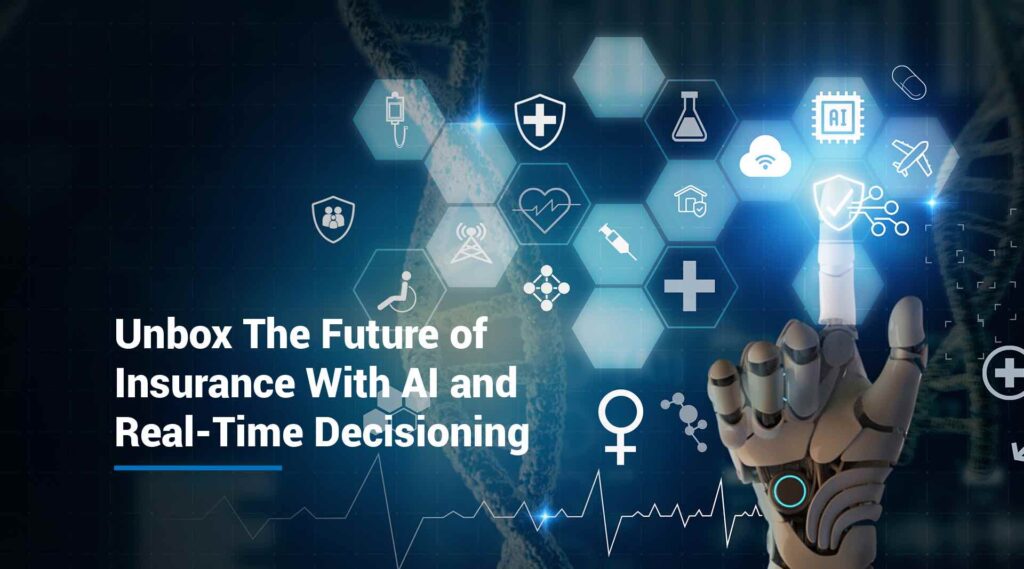
Unbox the future of insurance with AI and real-time decisioning Driving CPG success from ideation to profitability The insurance industry is facing a daunting challenge in detecting and preventing fraud. The Coalition Against Insurance Fraud reveals that insurance fraud costs the US economy at least $308.6 billion annually. Annual losses to US insurers due to fraud With such alarming statistics, it is essential for insurance companies to leverage advanced technologies like artificial intelligence (AI) to prevent and detect fraud before it becomes a liability. For example, a few months ago, a social media trend highlighted a security flaw in certain car models resulting in a spike in car thefts across the United States. On one hand, car owners were at a loss on how to protect their cars and their insurance claims. On the other hand, insurers were grappling with more claims than usual. The magnitude of the trend could have been contained by leveraging proactive, dynamic rules identified by trend-spotting AI. An AI-based insurance software could have quickly identified patterns about car thefts from the data feed. It could have identified the models affected, the areas where the thefts were happening, the customer profiles of the claimants, etc. Insurers could have used these insights to take proactive measures; even better, they could have implemented recommendations provided by the software. The insurance industry is highly competitive and is constantly evolving to meet the needs of new-age customers. Despite advances in technology and customer service, the industry still faces some challenges that need to be addressed. One of the concerns is customer dissatisfaction. Many customers are unhappy with the level of service they receive from their insurance providers, which can lead to negative reviews, lower customer retention rates, and reduced profitability. Another challenge that the insurance industry faces is the need to streamline and automate cumbersome manual processes. Many insurance providers still rely on traditional methods for underwriting and claims processing, which can be time-consuming and error-prone. This can lead to delays in claims processing and payments, which can further exacerbate customer dissatisfaction. Insurance management: The four pillars of success Thankfully, with Areteans’ AI solution, Digi Insurance, insurance companies can adopt a four-pillar approach to tackle these challenges. Proactive, predictive, personalized selling The first pillar involves a proactive approach to selling. AI-powered risk assessment and predictive analytics can be used to identify high-risk customers and offer them customized policies that meet their unique needs. Areteans’ Digi Insurance, for example, enables insurers to launch new products and services quickly by leveraging pre-built AI models for customer classification. With individualized plans and premiums, insurers can drive increased conversions and profitability. Dynamic recommendations go beyond the annual purchase and renewal approach to a continuous cycle as offerings constantly adapt to customers’ needs and behaviour patterns. Customer interactions become more meaningful as they are tailored to clients’ current and future needs. Increasing efficiency and accuracy in underwriting As per a survey by Accenture in 2022, 40% of underwriters’ time is spent on non-core and administrative activities. Automation and AI in underwriting can help insurers to take advantage of the increasing volume and variety of data available. By leveraging predictive analytics and multivariate rules, insurers can improve the accuracy of underwriting decisions and focus more on risk assessment, leading to better pricing. Additionally, customers will benefit from a less intrusive decision-making process. Our product offers a highly sophisticated underwriting system that provides enhanced underwriting controls through configurable and adaptive business rules, as well as proactive risk prediction. By utilizing analytics to power risk evaluation, risk selection, and underwriting decisions, our product aligns underwriting outcomes with profitability and risk objectives. This ensures that insurers can make informed decisions based on data-driven insights and achieve better outcomes for their customers and their business. Managing and mitigating risk The third pillar involves risk management and mitigation. With AI-powered risk assessment, insurers can identify high-risk customers and sell policies with the right conditions. Digi Insurance can recognize underwriting hazards and streamline risk selection. It can recognize the propensity of a claim based on the demography, the location, among other factors, effectively categorizing the person into predetermined pricing groups. By continuously processing vast amounts of structured and unstructured data on driving conditions, traffic incidents, and other vehicle and driver information, Digi Insurance can automate the determination of accurate risk profiles and decide on precise policy premiums. Streamlining and strengthening claims management The biggest issue facing insurers is managing claims, specifically bad or fraudulent claims. Around a fifth of the premium policy book of insurers can be classified as bad or excess claims, and depending on the sector, this can run into millions or billions of dollars. For example, providers can expect massive savings when it comes to bad claims in home insurance. A common fraud is buying insurance after a bad weather event and claiming it a month later. Digi Insurance helps identify cooling periods of policies in such scenarios, saving insurers a significant sum. In the US insurance market, excess claims significantly impact insurers’ bottom lines. Our AI-based solution, Digi Insurance can analyze claims data to identify and prevent wrong and fraudulent claims from being accepted or paid by the company. Detecting potential fraud, non-compliance, and other high-risk scenarios enables insurers to effectively prevent financial losses, improve customer loyalty, and maintain their reputation. Reimagining insurance with Digi Insurance The trend in the insurance industry is moving sharply towards AI. According to a PWC research, that almost two-third of insurance companies that have already invested in AI report better customer experience, while half of them report improved decision making. The 2022 Gartner CIO and Technology Executive Survey states around 35% of insurance CIOs are increasing their investments, and 61% consider AI as highly valuable in responding to industry trends. To state the undeniable importance of AI in streamlining claims and preventing bad ones, we can look at the healthcare industry, which is also turning to AI solutions to mitigate risks and prevent fraud. According to recent surveys, more than a
From Data to Delight: The Power of AI in CPG
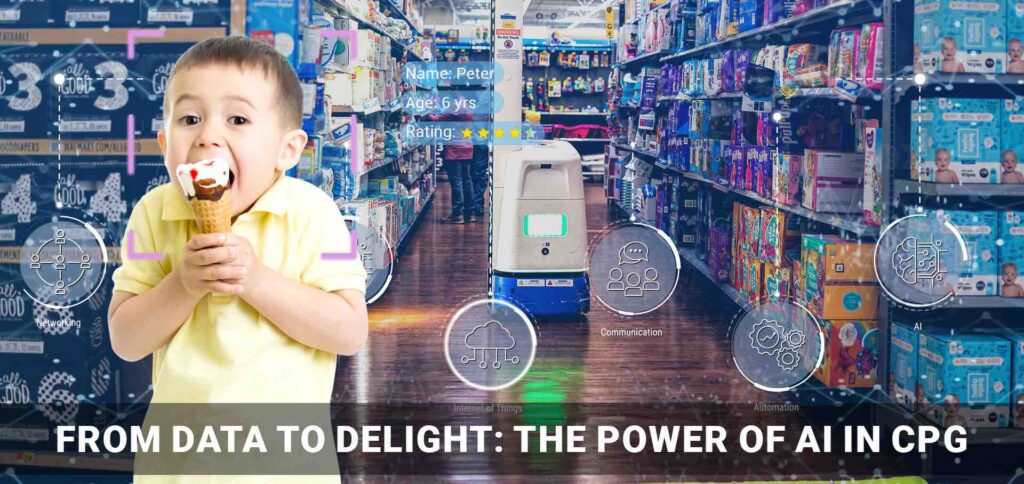
From Data to Delight: The Power of AI in CPG Driving CPG success from ideation to profitability Witnessing a child’s smile after being treated to ice cream on a scorching summer day or the satisfaction on the face of an expectant mother when her longing for dark chocolate is fulfilled is truly delightful. An emotional response, customer delight is crucial for enhancing brand reputation, elevating customer lifetime value, and ultimately improving the bottom line of the business. However, there are numerous obstacles that a consumer-packaged goods company must overcome to consistently achieve customer delight. High Lead Time A survey by Consumer Brands Association revealed that 47% of Americans surveyed had used online ordering for delivery or click-and-collect services during COVID-19. 77% of them plan to continue using them after the pandemic. Thorough research, testing, and quality management are necessary before launching products due to evolving demands, habits, sustainability concerns, and safety regulations. CPG companies usually take a considerable amount of time, ranging from several months to years, to launch a product. This significantly impacts their time-to-market and ability to outpace competitors. To address this, the R&D team needs tools that can help them swiftly identify customer requirements and develop unique products that can stimulate purchases simultaneously be 100% compliant with regulations and maintain brand reputation. Inadequate use of data CPG firms have various sources of data, including enterprise systems, CRM, market research, behavioral data, web, and social platforms, resulting in an abundance of data points. However, having access to data alone does not guarantee comprehension. The ability to pivot and adapt to market dynamics depends on having clean, real-time information and analytics. Conventional systems are fragmented and lack the intelligence needed to convert data into information and actionable insights for prompt, precise decision-making. Having a powerful tool, that brings harmony across fragmented systems, people with diversified routine jobs, and orchestrating data is the need of the hour. Demand and supply challenges As per a BCG study, a leading e-tailer promises delivery in one hour today compared to same-day delivery in 2010. Similarly, a major European supermarket has reduced its delivery time from 5-7 days in 2010 to same-day delivery in 2021. Meeting the needs of today’s customers and operating in a complex business environment pose significant challenges for CPG companies. The rise of omnichannel commerce and increasing customer expectations have created a demand and supply imbalance. Additionally, unforeseen events such as natural disasters or geopolitical tensions can disrupt supply chains and impact logistics. For instance, the recent earthquake in Turkey has severely damaged the infrastructure of Iskenderun port, which is a critical shipping hub for corn, wheat, and bran – essential raw materials for CPG firms. This has caused significant obstacles in the transportation of these materials. As per a 2020 KPMG report that surveyed over 12,000 customers globally, customers are more digital, financially constrained, and more thoughtful in their buying decisions. With the evolution of technology and changing business conditions, customers and their buying process have also evolved. Customers now interact with firms through various channels and rely on multiple data points, such as online advertisements and reviews, to make their purchase decisions. Lack of support from strategic functions For CPG firms to succeed in the highly competitive environment, strategic functions like finance and sustainability management which may be outside the supply value chain, have to be integrated innovatively. Traditional payment processes touch several systems that are not integrated closely and include numerous manual touch points, leading to inefficiency and risks like fraudulent payments. As per the Paris agreement, an international treaty on climate change, starting 2024, countries will report transparently on actions taken and progress in climate change mitigation, adaptation measures, and support provided or received. As a result, CPG firms will have to accelerate their climate change mandates and require an integrated, automated approach to balance profitability with sustainability. A digital approach to future-proofing CPG A CPG firm must constantly delight customers and exceed their expectations. How can this be achieved consistently? Investing in intelligent R&D operations By utilizing an AI-powered solution, R&D teams can improve the success rate of new product launches. With workflow intelligence, you can establish standards and automatically evaluate product ideas based on various parameters, such as target audience and location. This not only reduces the need for rework during product development but also results in decreased time-to-market and a competitive advantage. Implementing a comprehensive AI-based risk management framework that incorporates data and analytics to automatically assess new product ideas for safety and risk can provide significant benefits. By integrating R&D with Product Lifecycle Management (PLM) applications, you can standardize the product development process and include compliance evaluation and risk mitigation measures. Implementing an AI-based agile strategy to stay ahead of competition Leveraging data and artificial intelligence (AI), CPG companies can gain a competitive edge in managing both current and future supply and demand challenges with increased insights and agility. For instance, implementing processes such as smart onboarding of suppliers, automated verification & real-time monitoring of suppliers, and leveraging data for negotiation strategies, will increase transparency and support healthy business relationships. CPG firms can implement a cloud-based collaborative procurement process managed centrally across geographies. This would create a shared workspace for decision-makers across the organization, decreasing supply risks and promoting collaboration. With a unified and secure data and analytics system, decision-making can become more robust and collaborative. This will help better handle unexpected inventory challenges and meet the increasing expectations of consumers. To enhance customer satisfaction and transparency, you can implement an automated demand workflow that addresses specific business cases such as overdue payments, order changes, returns, refunds, and claims. Additionally, by offering advanced chatbots and self-service portals, you can provide an omnichannel experience that delights digitally savvy customers. Transforming logistics As customer expectations and environmental consciousness increase, a CPG firm that can optimize logistics costs and reduce carbon footprint will have better business results. An AI-based logistics solution can help manage inventory, automate stock fulfillment, optimize fleet and space utilization, and
CZERO – From emission measurement to management
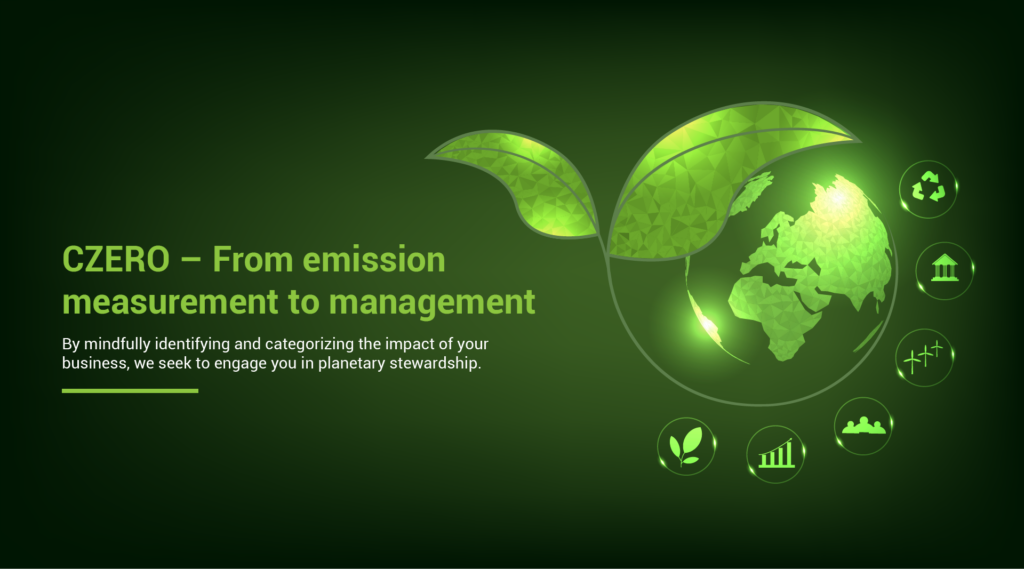
A 2021 survey by BCG of 1,290 organizations worldwide finds, 85% of organizations are concerned about reducing their greenhouse gas emissions. To reduce the negative impact of their operations on the environment, 96% of them had set some targets for reducing emissions. However, only 11% of them have been able to reduce their emissions in line with their goals over the past five years. Under the enhanced transparency framework (ETF), established within the Paris agreement, an international treaty on climate change, starting 2024, countries will report transparently on actions taken and progress in climate change mitigation, adaptation measures and support provided or received. As a result, businesses must comply with expectations to track their carbon footprint more comprehensively and take concrete steps to mitigate it. Measurement is The Key A company’s carbon footprint is the amount of GHG emissions that are released into the environment as a result of its operations. Carbon footprints for businesses are typically divided into three Scopes: • Scope 1 covers direct emissions from business.• Scope 2 entails indirect emissions such as electricity. These are emissions produced off-site from energy used on-site.• Scope 3 emissions include those from other parts of the value chain. The Greenhouse Gas Protocol establishes comprehensive global standardized frameworks to measure and manage emissions across a company’s operations and value chains. The need of the hour is a tool that can provide an accurate picture of the actual processes, activities, and resources that directly contribute to the organization’s carbon emissions. Knowing the positive or negative impact can help manage emissions intelligently through quantitative measurement parameters. After all, you can manage only what you can measure! A Guided Journey from Monitoring to Management with C-ZERO Measuring your carbon footprint is critical to identify carbon reduction opportunities and create a robust sustainability strategy. C-ZERO, an AI-powered application developed by Areteans, not only helps measure your company’s carbon emissions, but also provides a guided journey from monitoring to management. C-ZERO –Measure, Manage, Monitor Carbon Emissions across The Journeys of Your Business It identifies end-to-end emissions produced from various journeys of the business and steers you through the capture process to monitor emissions at every stage, recommend & automate improvement initiatives, and ultimately reduce emissions. Powered by Pega’s BPM Workflow, dynamic case management and Next-Best Action capabilities, the real value of C-ZERO lies in its power to capture emissions data from actual processes. Gathering data from specific emission points, it creates a guided path to reduce emissions. SOLUTION The C-ZERO applications identify the end-to-end emissions produced from a particular journey, guiding you through the capture process to reduce emission actions using the power of dynamic case management. Jatin Patel, Senior Vice President and Regional Head of Europe at Areteans, believes that one of the critical first steps towards carbon neutrality is accurately measuring climate impact and monitoring it regularly. “With technologies like AI and tools like C-ZERO, organizations can adopt a scientific approach to turn their climate ambitions into concrete action,” he says. Track, Analyze, and Reduce Your Carbon Footprint C-ZERO has innovative features across three phases that can help you achieve your carbon neutrality goals – Set Goals The application provides the following for you to set your carbon neutral goals: Guided forms to set goals An extensive repository of contributing entities to select from Industry and sector specific drivers and coefficients Extendable data capture forms Guided and configurable flows for easy adoption Monitor and Plan You can get accurate data, efficient calculations and end-to-end visibility of the process with: Connectors to enable central repository for carbon tracking Benchmarking carbon emission calculations based on market insights Prebuilt integrations to monitor carbon spend Automated and manual tracking of emissions A Proactive actionable plan Automate Action CZERO helps with strategies to reduce carbon footprints by providing: Actionable suggestions based on real-time insights Details of high-emission segments and clients Prebuilt integrations with third party systems to get actionable insights Reports to satisfy regulatory requirements Intelligent recommendations for steps to offset energy spends The application uses Pega’s Situational Layer Cake to dynamically adapt to customer needs across different verticals. It helps corporations in strengthening their green credentials sustainably by: Capturing emission drivers for all processes and entities Calculating emissions accurately using dynamic case management Presenting an actionable plan to implement dynamic and automated reduction actions Continuous and real-time monitoring at individual process levels with actionable insights Given its distinct capabilities to drive a guided journey, C-ZERO has been recognized as a product that can accelerate progress towards reducing the environmental impact of organizations. It has been conferred with THE SEAL (Sustainability, Environmental Achievement & Leadership) SUSTAINABLE PRODUCT AWARD for 2022 in recognition of a product that is most innovative and impactful to ensure a sustainable future. Mobilizing AI to Fight Climate Change Companies are accelerating their climate change mandates because such action presents significant benefits. From cost savings, resilience to financial and reputation risk, talent attraction and retention to customer loyalty, transitioning to a low-carbon economy is a responsible business opportunity. But companies continue to set broad emission reduction targets that are usually arbitrary and typically conservative. A multi-pronged approach that works at a granular level is critical to realize carbon reduction targets and transition to net zero. An AI-based solution that can adapt to changing business needs and regulations, provide accurate monitoring capabilities, and drive a guided journey can put such an approach to action most optimally. Combining the power of AI and dynamic case management capabilities of Pega, C-ZERO can identify the end-to-end emissions produced from a particular journey. It can set carbon-neutrality targets and monitor carbon emissions using fully automated data feeds. Additionally, it suggests proactive methods to reduce emissions. To know more about how C-ZERO automates carbon capture and allows you to focus on taking meaningful actions guided through a model, get in touch with us at: [email protected]. We can enable you to incorporate sustainability in your business processes, comply with the increasing regulatory demands and help you reduce your carbon footprint. Know more
Need Analysis Tool – The Fastest Way To Achieve Your Business Goals
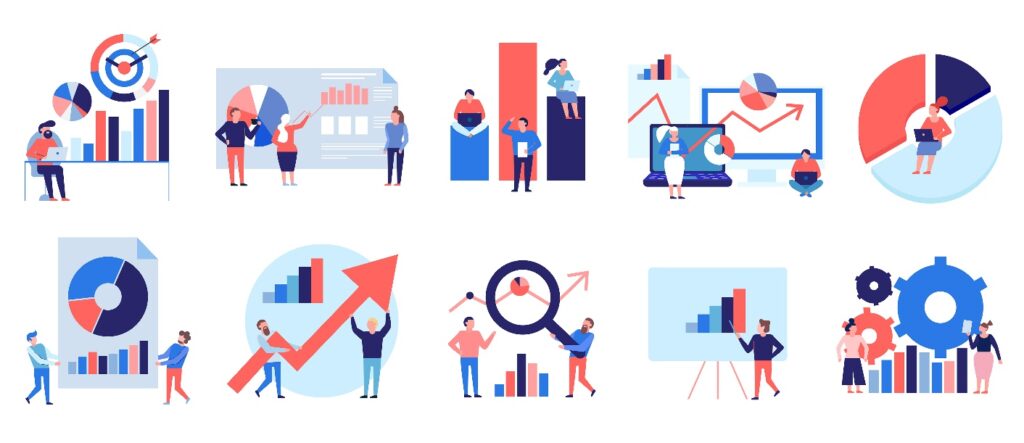
Need Analysis Tool – ‘FASTEST’ wayTo Achieve Your Business Goals Need analysis helps organizations to be proactive before potential problems become real problems. One of the key benefits of need analysis is being able to detect the issues affecting business performance and getting a clear understanding of areas to improve the workflow. What is a Need Analysis Tool? Need Analysis Tool is a one-stop-shop for the analysis and identification of needs for each department of any organization. The ability to identify problems within 60 minutes makes the tool unique. The reduced decision-making time makes it a remarkable feature. The tool provides visibility for the solution with details of the timeline of delivery. Traditional methods that rely on technology take more than 4 months. The PEGA backed tool does intense analysis and finds the best solution in a very short time. PEGA’s need assessment capability combines additional input into customer preferences and then selectively represents all available recommendations. NAT from Areteans Solutions In today’s world of information overload, the challenge is finding a solution to the problem in time, leading the fastest way to achieve your goals. NAT recognizes the gaps in your business well in advance. It helps customers find the pre-eminent outcome to their business problems. This tool analyzes and suggests the customer situation of the biggest problem using 100s of use cases and selects the best solution ready to be deployed. Unique features of NAT 100% customer-relevant conversations The most important step in NAT is to communicate with customers to understand what problems they may have. This phase of discussion is necessary to clarify the nature and role of business gaps. This tool lets clients understand Pega and how they want to understand it, based on past user behaviour and experience. The session can last about 60 minutes and let the client go through one of the two methods they expect: Industry – In-depth study of over 100 use cases of client business industry. Industry Agnostics – Explore in-depth to learn more about the best practices in the industry globally. If the client wants to explore more in a particular industry, say banking or maybe say in the airline industry. The outcome of the technical solution ultimately is not predetermined but is based on what the client has chosen. The analysis tool segregates clients’ interests as per what they chose and recommends solutions in the outcome. The following focus areas in the tool are assessed: Expectations – Choose the most appropriate one from the available options. IT Portfolio – Understand what Pega can do for your business in terms of new capabilities or time flow in the flow of information or transactions. Results – Find results that resonate most in your business. Remedy – Understand the problems and consequences solved by PEGA. Remove ambiguity in tech selection for business problem-solving The design of NAT ensures that the entire process does not need to be rediscovered for the new session. The analytical process refers to previous cases so that you can learn from the best applications already distributed. The following features help to eliminate any ambiguity: Provides the most relevant use cases related to your industry among the 11 major industries. Alternatively, clients can retrieve related usage cases from 80+ sections. Industry-agnostic best practices can also be discovered. Sort PEGA based on the relevant use cases only for your needs and select such use cases from a wide range of options. Learn about the actual results that other leaders can achieve in the direct deployment based on the usage cases that resonate with you. Learn about measures that can be implemented based on the results you prefer, and find deliverables within 30-60-90 days. Enter basic details and your custom demo and get access to the basic business requirements documents. Live tool for GTM The tool does the segmental data analysis and problem-solving for various industries and segments globally. For example, customer expectations or usage and insights into the affected segment. The resultant solution is readily implementable, making the tool go to market. Predictive inputs for the PEGA sales team Based on past user behaviour and experiences, the sales team can make predictable input. If the CTO of an insurance company addresses some gaps in the business and pays attention to them, the next time, the insurance customer will benefit from the previous lessons already created in the tool for the insurance domain. Why Areteans? Areteans is a global services and solutions provider serving a large range of ready-to-deploy solutions across the industry. Areteans, in partnership with your business, helps gain insights into your business ecosystem and leverage your potential. Areteans develops customer relationships through powerful insights, data and digital automation. Collaborative Pega implementations have favoured out-of-the-box solutions in areas such as BPM CRM, sales and marketing, call centres and BPO, operations and legacy transformations. In just 60 minutes, Areteans’ NAT with Smart Data Analysis can help you identify the impact in your business, drill down to department wise analysis of problems and suggest the best remedial scenario to overcome the gap. The 30-60-90 day plan assures the working deliverables you can choose as the best solutions. Needy businesses can reach us to drive a collaborative assessment of their business health.
CLM:Automate and Scale ‘YOUR’ Banking Operations

CLM:Automate and Scale ‘YOUR’ BankingOperations Banking operations can rapidly become complicated, time-consuming and costly when they need to hire extra staff just to keep up with the growth. However, some tools can help make a banking and finance company’s operations much easier. Client Lifecycle Management or CLM is one such tool which is an analytical process that helps manage the banking clients’ lifecycles, encourage client retention and boost the bank’s profitability. CLM focuses on a complete chain of client transactions and is designed to generate easily-digestible results. While CRM helps preserve clients’ data, CLM helps preserve the client itself. CLM covers the banking operations overseen by a Relationship Manager (RM), who interacts with various departments across the bank for the client if needed. It creates a 360-degree client lifecycle view by capturing data points to generate insights into client preferences at any point in time while associating with the bank. Automation of Banking Operations Customers engage with a bank across institutional banks. But siloed systems and lack of transparency can create gaps in customer servicing. However, clients expect an experience similar to global standards, so banks are trying their best to eliminate legacy systems and manual processes and bring in automation in their banking operations. The banking sector, through automation, intends to streamline its processes. As a result, some banks are looking at a new generation of regtech (regulation technology) solutions as a silver bullet to ease the log-jam of data and processes. But regtech must be supported by proven technology that is part of a larger fintech strategy. The main aim is to ensure that identification, client onboarding, and verification processes use end-to-end applications that allow picking up desired components and plugging in seamlessly into an existing CLM set up in the bank. This is where Robotic Process Automation or RPA comes into play. The RPA can be fully embedded in the CLM and KYC applications of fintech organisations to coordinate and automate how KYC and CLM processes work. The main aim is to activate multiple data sources and applications in such sequences that help augment the work to be done by the client onboarding team. RPA captures data from legacy systems and collates it to form a single customer view across geographies and lines of banking business. Banks are turning to the robotic approach as part of a cybersecurity setup to reduce FTEs, cut down errors to zero and speed up the time needed to implement them as part of banking operations. Automation within CLM and KYC applications enables the banking sector to intelligently optimise how the work is carried out by humans and robots. The use of a centralised and globally scalable end-to-end solution helps seamlessly infuse robotic automation within the banking operation for onboarding and KYC transformation. Fintech organisations like banks and finance corporations can run tasks unattended, thereby ensuring that all extenuating risks are taken care of and that these meet all regulatory requirements as mandated by the government and regulatory authorities. In addition, this automation helps banking and finance sector employees be more productive by freeing them from somewhat tiresome processes linked to KYC verification and focusing more on delivering better customer service. Why NextGen CLM NextGen CLM helps banks automate and scale up their banking operations and boost efficiency by providing a centralised view of all their banking activities across various accounts and countries. In addition, NextGen CLM provides finance companies with a comprehensive and secure system that will help them acquire more customers and manage KYC requirements in compliance with banking regulations. NextGen CLM has been developed by Areteans Technology Solutions, a provider of business services and solutions to help transform them and evolve digitally by executing Pega implementations. In addition, Areteans focuses on developing solutions that help clients proactively collaborate with customers.
CZERO, your ‘green’ tool for a sustainable future
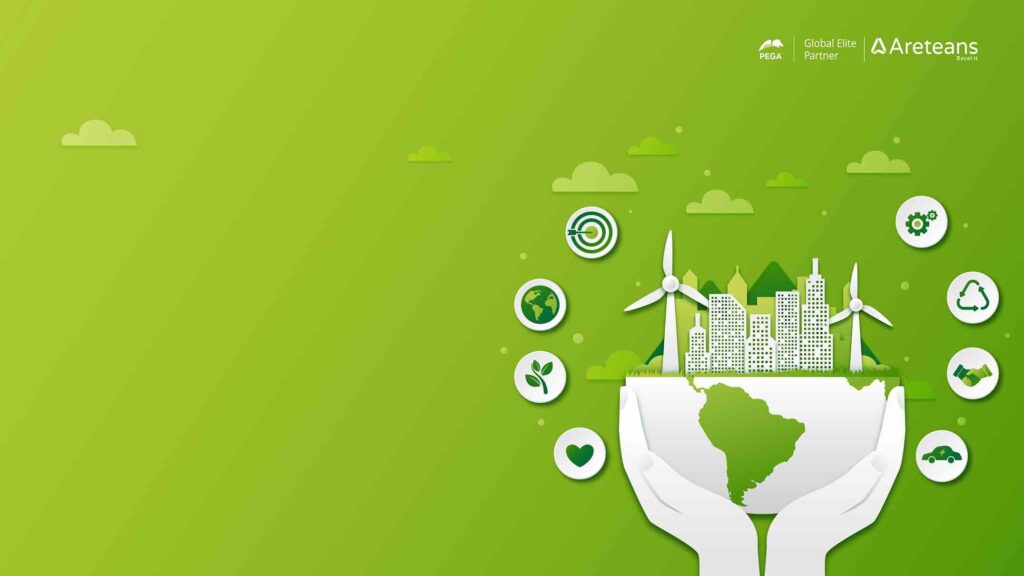
CZERO, your ‘GREEN’ tool for a sustainable future Dear earthling, Let us start with consuming this bitter truth pill: From what you choose to eat, your mode of commute, to the rubbish you generate daily has an irrevocable impact on nature. So, climate change is on us. The earthquakes, the reduced air quality, the droughts, the heat waves… everything is on us. Now, moving on to a billion-dollar question: How do we put our green foot forward to achieve a sustainable future? We humans have got a lot of damage control to do. Where do we start? We believe it should start with reducing carbon footprint, both at an individual and an organizational level. In this green journey, it is important to get our basics right. What is a carbon footprint? A carbon footprint is the total amount of greenhouse gases (including carbon dioxide and methane) that are generated by our actions. Globally, the average carbon footprint is around 4 tons. For us to avoid the global temperature rise, the average global carbon footprint needs to drop under 2 tons by 2050. How do we reduce our carbon footprint? Well, every small action of yours will lead to a bigger impact. Every conscious decision ranging from eating less meat, carrying your own bag to the supermarket, to choosing to take public transport, makes a big difference. To support our efforts, wouldn’t it be cool to have a powerful AI-led application helping us proactively reduce our carbon footprint? Introducing – CZERO. CZERO is an application that identifies end-to-end emissions produced from a particular journey, guiding you through the capture process to reduce emissions using dynamic case management. There’s more. CZERO goes a step further than any other tracker by helping you/your organization experience a guided journey towards sustainability. It includes specific insights into the actual processes, activities, and resources that directly contribute to carbon emissions. The following are the features that help both individuals/organizations in reducing carbon footprint: Enhanced emission monitoring capabilities Real-time carbon footprint feedback Flexibility to integrate with any third-party enterprise solutions and internal processes Adapts to each customer needs across multiple verticals Intelligent proactive recommendations to let you control which improvement initiatives should be implemented Furthermore… CZERO application provides automation to capture carbon emissions and helps you take meaningful actions guided through a maturity model. The application uses Pega’s BPM workflow to enable organizations/individuals to define their carbon-neutral goals and capture steps to achieve it. Its dynamic case management approach helps gather accurate data from various sources and stakeholders leading to efficient calculation and ultimately providing end-to-end visibility of the complete process. Graphs and reports help monitor the status and prompt necessary actions to be taken for carbon reduction. Basically, CZERO is your ‘green’ tool for a sustainable future. Just choose to be a responsible earthling and we will help you achieve your carbon-neutral goals. We will also help you redesign your existing processes and enhance your ‘green’ experience.
